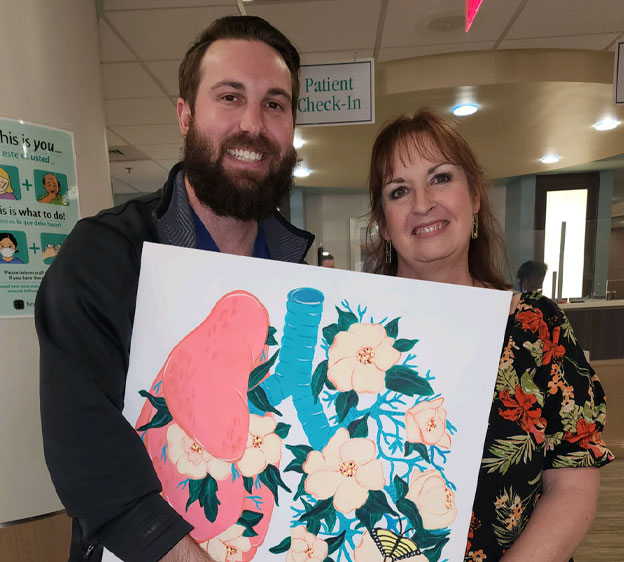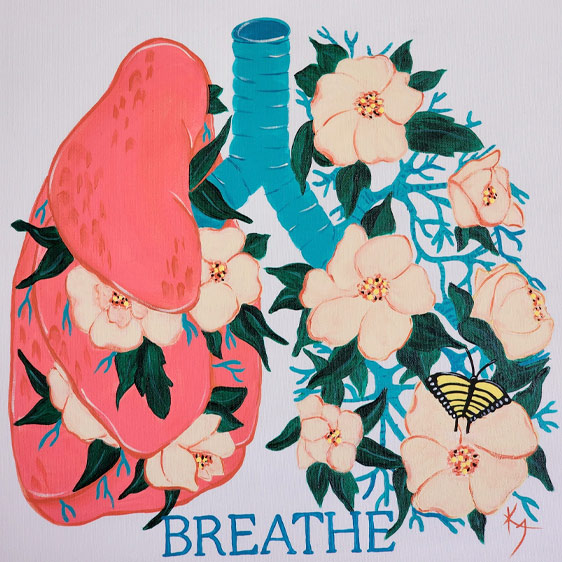
Before she landed in the Lowcountry, 61-year-old Kandace Palmer had never picked up a drawing pencil, much less a paintbrush. Now, owner and resident artist at Southern Palette Art Studio in Beaufort, Kandace’s love affair with painting came later in life and it came on a whim, just like her family’s decision to move from New York to St. Helena Island in the fall of 2016.
“It was literally a flip of a coin,” Kandace remembers. “After a vacation in Myrtle Beach, my husband, Robert, and I tossed around the idea of relocating, and he started a job search. That didn’t take long. In fact, we weren’t quite ready when the offer came, so we decided to flip a coin. Heads, we would go. Tails we would stay.”
Heads it was, so they relocated on the heels of Hurricane Matthew, along with their grown twin sons — Robert Jr., an emergency medical technician, and Ray, now a Beaufort city police officer.
Chest Pressure Prompts Medical Visit
One day a friend suggested that Kandace check out a local “sip and paint” class. For Kandace, it was love at first sight. Or first sketch.
“I just had a natural affinity for it,” she said. “It had been there all the time, and I had no idea.”
Kandace soon became one of the sip and paint studio’s biggest fans, and in May 2018, when the owner decided to sell the popular studio, Kandace didn’t think twice. The transition from customer to studio owner was seamless, and for the next four and a half years, everything was just fine.
Until one day last February, when it wasn’t. Kandace remembers it vividly.
“I felt something just wasn’t right. My chest was tight. But there was no pain. It felt like a bear hug.”
Kandace had her son Robert Jr. check her blood pressure that evening and it was elevated, but not dangerously so. They checked it again the next morning, and again it was high. Kandace decided to go to an Express Care clinic where they did an EKG and blood work. The test results were inconclusive, so she was advised to go to the emergency room at Beaufort Memorial and get checked out more thoroughly.
Read More: When to Visit the Hospital for Chest Pain
“I almost didn’t go,” she admits. “I felt kind of foolish. It was probably nothing. I had always been perfectly healthy. I don’t know what made me change my mind, but I’m glad now that I did, and I’m even more glad that Dr. Fletcher was on duty in the ER that day.”
Dr. Timothy Fletcher, Beaufort Memorial emergency medicine specialist, remembers that day well, too.
“Kandace was complaining of chest pressure, a squeezing around her chest,” he says. “In the Emergency Department, we take chest pain seriously, as certain presentations can be associated with life-threatening illnesses, so the triage team got her back to me as quickly as possible, got an IV running and did the required blood work.”
Because of the chest pressure, Dr. Fletcher also included a D-dimer test, which can diagnose a pulmonary embolism or blood clot.
“The D-dimer showed a significantly high marking for blood clotting,” he says. “So the next move was to order a CT Scan of Kandace’s lungs.”
Read More: Pulmonary Embolism: Symptoms, Diagnosis and Treatment
The scan revealed that Kandace had several blood clots in both lungs, which was very concerning to Dr. Fletcher.
“The clot burden was high and needed to be treated immediately,” he says. “Once we knew what we were dealing with, we started her on a strong blood thinner, admitted her to the hospital, and transferred her over to the inpatient team.”
Piecing Together the Puzzle
Kandace was diagnosed with a pulmonary embolism, a sudden, life-threatening blockage of the pulmonary artery, usually resulting from a blood clot that has traveled through the bloodstream to the lungs. According to the American Lung Association, pulmonary embolism affects 1 in 1,000 people in the United States every year.
“It was such a scary experience,” Kandace remembers. “But Dr. Fletcher made me feel totally and completely safe the entire time. Like he was going to personally make sure I was okay. The whole ER team was that way. I felt like they were there just for me.”
Once Kandace was admitted to the hospital and transferred to a room upstairs, the ER crew’s job was successfully done. They had found the problem and started the process to fix it.
“Emergency medicine is like a puzzle,” Dr. Fletcher says. “Every patient comes in without a diagnosis. There are a ton of pieces that go into every diagnosis, and each member of the team has a role to play in putting the pieces together to ensure the correct diagnosis is made as quickly and efficiently as possible. It’s a team sport, that’s for sure, and we’ve got a good one.”
 A month after her release from the hospital, Kandace returned to Beaufort Memorial with a heartfelt and hand-painted thank you gift for the ER doctor who saved her life.
A month after her release from the hospital, Kandace returned to Beaufort Memorial with a heartfelt and hand-painted thank you gift for the ER doctor who saved her life.
“I wanted one side to look like a real lung so people would know what the painting was about, and I wanted the other side to be pretty and airy and healthy, the way I felt after Dr. Fletcher saved my life in the ER that day.”
Dr. Fletcher was delighted to see both Kandace and her painting.
“We don’t always get a ton of recognition for what we do, so Kandace’s gift was a heartwarming and beautiful surprise,” he says. “The fact that she cared enough to show her gratitude was very special.”
Find out how the pulmonology team at Beaufort Memorial can help you avoid these life-threatening blood clots. Call 843-707-8040 to schedule an appointment with a member of our pulmonology team.
